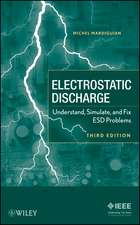Analog Layout Generation for Performance and Manufacturability: The Springer International Series in Engineering and Computer Science, cartea 501
Autor Koen Lampaert, Georges Gielen, Willy M.C. Sansenen Limba Engleză Hardback – 30 apr 1999
In the past, automatic analog layout tools tried to optimize the layout without quantifying the performance degradation introduced by layout parasitics. Therefore, it was not guaranteed that the resulting layout met the specifications and one or more layout iterations could be needed. In Analog Layout Generation for Performance and Manufacturability, the authors propose a performance driven layout strategy to overcome this problem. In this methodology, the layout tools are driven by performance constraints, such that the final layout, with parasitic effects, still satisfies the specifications of the circuit. The performance degradation associated with an intermediate layout solution is evaluated at runtime using predetermined sensitivities. In contrast with other performance driven layout methodologies, the tools proposed in this book operate directly on the performance constraints, without an intermediate parasitic constraint generation step. This approach makes a completeand sensible trade-off between the different layout alternatives possible at runtime and therefore eliminates the possible feedback route between constraint derivation, placement and layout extraction.
Besides its influence on the performance, layout also has a profound impact on the yield and testability of an analog circuit. In Analog Layout Generation for Performance and Manufacturability, the authors outline a new criterion to quantify the detectability of a fault and combine this with a yield model to evaluate the testability of an integrated circuit layout. They then integrate this technique with their performance driven routing algorithm to produce layouts that have optimal manufacturability while still meeting their performance specifications.
Analog Layout Generation for Performance and Manufacturability will be of interest to analog engineers, researchers and students.
| Toate formatele și edițiile | Preț | Express |
|---|---|---|
| Paperback (1) | 635.31 lei 6-8 săpt. | |
| Springer Us – 9 dec 2010 | 635.31 lei 6-8 săpt. | |
| Hardback (1) | 641.71 lei 6-8 săpt. | |
| Springer Us – 30 apr 1999 | 641.71 lei 6-8 săpt. |
Din seria The Springer International Series in Engineering and Computer Science
-
 Preț: 119.98 lei
Preț: 119.98 lei - 24%
 Preț: 1041.97 lei
Preț: 1041.97 lei - 20%
 Preț: 422.81 lei
Preț: 422.81 lei -
 Preț: 206.36 lei
Preț: 206.36 lei - 20%
 Preț: 313.26 lei
Preț: 313.26 lei - 20%
 Preț: 643.50 lei
Preț: 643.50 lei - 18%
 Preț: 1225.62 lei
Preț: 1225.62 lei - 18%
 Preț: 965.02 lei
Preț: 965.02 lei - 20%
 Preț: 646.12 lei
Preț: 646.12 lei - 18%
 Preț: 948.79 lei
Preț: 948.79 lei - 20%
 Preț: 646.62 lei
Preț: 646.62 lei - 15%
 Preț: 637.46 lei
Preț: 637.46 lei - 20%
 Preț: 643.83 lei
Preț: 643.83 lei - 18%
 Preț: 949.23 lei
Preț: 949.23 lei - 20%
 Preț: 644.48 lei
Preț: 644.48 lei - 20%
 Preț: 994.92 lei
Preț: 994.92 lei - 20%
 Preț: 645.97 lei
Preț: 645.97 lei - 18%
 Preț: 946.87 lei
Preț: 946.87 lei - 20%
 Preț: 995.57 lei
Preț: 995.57 lei - 18%
 Preț: 956.99 lei
Preț: 956.99 lei - 20%
 Preț: 644.98 lei
Preț: 644.98 lei - 15%
 Preț: 649.54 lei
Preț: 649.54 lei - 18%
 Preț: 950.21 lei
Preț: 950.21 lei - 18%
 Preț: 1221.38 lei
Preț: 1221.38 lei - 18%
 Preț: 957.62 lei
Preț: 957.62 lei - 15%
 Preț: 643.99 lei
Preț: 643.99 lei - 18%
 Preț: 948.47 lei
Preț: 948.47 lei - 18%
 Preț: 947.35 lei
Preț: 947.35 lei - 20%
 Preț: 1284.65 lei
Preț: 1284.65 lei
Preț: 641.71 lei
Preț vechi: 754.95 lei
-15% Nou
Puncte Express: 963
Preț estimativ în valută:
122.81€ • 127.88$ • 103.79£
122.81€ • 127.88$ • 103.79£
Carte tipărită la comandă
Livrare economică 10-24 martie
Preluare comenzi: 021 569.72.76
Specificații
ISBN-13: 9780792384793
ISBN-10: 0792384792
Pagini: 175
Ilustrații: XV, 175 p.
Dimensiuni: 155 x 235 x 13 mm
Greutate: 0.45 kg
Ediția:1999
Editura: Springer Us
Colecția Springer
Seria The Springer International Series in Engineering and Computer Science
Locul publicării:New York, NY, United States
ISBN-10: 0792384792
Pagini: 175
Ilustrații: XV, 175 p.
Dimensiuni: 155 x 235 x 13 mm
Greutate: 0.45 kg
Ediția:1999
Editura: Springer Us
Colecția Springer
Seria The Springer International Series in Engineering and Computer Science
Locul publicării:New York, NY, United States
Public țintă
ResearchCuprins
1 Introduction.- 2 Performance Driven Layout of Analog Integrated Circuits.- 3 Module Generation.- 4 Placement.- 5 Routing.- 6 Implementation.- 7 General Conclusions.

















